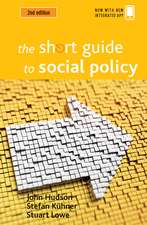A Complexity Theory for Public Policy: Routledge Research in Public Administration and Public Policy
Autor Goktug Morcolen Limba Engleză Paperback – 13 feb 2014
Din seria Routledge Research in Public Administration and Public Policy
-
 Preț: 152.57 lei
Preț: 152.57 lei -
 Preț: 311.33 lei
Preț: 311.33 lei -
 Preț: 714.88 lei
Preț: 714.88 lei -
 Preț: 361.99 lei
Preț: 361.99 lei -
 Preț: 155.43 lei
Preț: 155.43 lei -
 Preț: 356.31 lei
Preț: 356.31 lei - 19%
 Preț: 259.31 lei
Preț: 259.31 lei - 31%
 Preț: 761.76 lei
Preț: 761.76 lei -
 Preț: 186.14 lei
Preț: 186.14 lei - 9%
 Preț: 934.94 lei
Preț: 934.94 lei -
 Preț: 367.66 lei
Preț: 367.66 lei -
 Preț: 383.93 lei
Preț: 383.93 lei -
 Preț: 415.14 lei
Preț: 415.14 lei -
 Preț: 449.41 lei
Preț: 449.41 lei - 17%
 Preț: 269.80 lei
Preț: 269.80 lei - 18%
 Preț: 1053.92 lei
Preț: 1053.92 lei -
 Preț: 185.61 lei
Preț: 185.61 lei - 26%
 Preț: 762.97 lei
Preț: 762.97 lei - 18%
 Preț: 1002.95 lei
Preț: 1002.95 lei - 18%
 Preț: 702.40 lei
Preț: 702.40 lei - 17%
 Preț: 142.32 lei
Preț: 142.32 lei -
 Preț: 187.72 lei
Preț: 187.72 lei - 31%
 Preț: 763.00 lei
Preț: 763.00 lei - 18%
 Preț: 1060.87 lei
Preț: 1060.87 lei -
 Preț: 364.17 lei
Preț: 364.17 lei - 18%
 Preț: 995.54 lei
Preț: 995.54 lei -
 Preț: 186.53 lei
Preț: 186.53 lei - 18%
 Preț: 1063.65 lei
Preț: 1063.65 lei -
 Preț: 449.41 lei
Preț: 449.41 lei -
 Preț: 441.91 lei
Preț: 441.91 lei -
 Preț: 432.29 lei
Preț: 432.29 lei - 31%
 Preț: 766.66 lei
Preț: 766.66 lei - 18%
 Preț: 1065.40 lei
Preț: 1065.40 lei -
 Preț: 385.91 lei
Preț: 385.91 lei -
 Preț: 363.03 lei
Preț: 363.03 lei
Preț: 489.48 lei
Nou
Puncte Express: 734
Preț estimativ în valută:
93.66€ • 98.05$ • 77.50£
93.66€ • 98.05$ • 77.50£
Carte tipărită la comandă
Livrare economică 05-19 aprilie
Preluare comenzi: 021 569.72.76
Specificații
ISBN-13: 9781138015746
ISBN-10: 1138015741
Pagini: 1
Dimensiuni: 152 x 226 x 18 mm
Greutate: 0.46 kg
Editura: Routledge
Seria Routledge Research in Public Administration and Public Policy
ISBN-10: 1138015741
Pagini: 1
Dimensiuni: 152 x 226 x 18 mm
Greutate: 0.46 kg
Editura: Routledge
Seria Routledge Research in Public Administration and Public Policy
Notă biografică
Goktug Morcol is an Associate Professor of Public Administration and Policy in the School of Public Affairs at The Pennsylvania State University in Harrisburg. His research interests are complexity theory, metropolitan governance, business improvement districts, and research methodology. He teaches courses in research methods, program evaluation, and policy analysis.
Cuprins
Introduction Part I: Concepts 1. Complexity Theory and Public Policy 1.1 Public Policy: Simple or Complex? 1.2 A Definition of Public Policy from a Complexity Theory Perspective 1.3 What is Complexity? 1.4 Complex, Complicated, and Simple 1.5 Complex Systems or Complex Adaptive Systems? 1.6 Chapter Summary 2. Systems and Systemness 2.1 What is a "System"? 2.2 Open and Closed Systems 2.3 Systems and Networks 2.4 System Stability and Dynamics: Structures and Procesees 2.5 Systemness and System Integration 2.6 Who Defines a Systems 2.7 Chapter Summary 3. Emergence 3.1 Emergence, Micro-Macro Relations, and Agents and Structures 3.2 A History of the Concepts of Holism and Emergence 3.3 Emergence and Complexity Theory: An Overview 3.4 Emergence and Macro Structures 3.5 Mechanisms of Emergence 3.6 Irreducibility 3.7 Downward Causation 3.8 Structuration 3.9 Chapter Summary and Implication for Policy 4. Self Organization 4.1 A Brief History of Self-Organizational Thinking 4.2 Issues in Self-Organization 4.3 What is Self? 4.4 Self-Organizations Agents 4.5 Self-Organization in Nature 4.6 Autopoiesis and Self-Referentiality 4.7 Applications of Self Organization in Management, Planning and Policy 4.8 Chapter Summary and Implications for Public Policy 5. System Dynamics 5.1 System Dynamics and Complexity Theory 5.2 Self-Organized Criticality 5.3 Self-Referentiality 5.4 Co-evolution 5.5 System Dynamics and Public Policy 5.6 The Five Propositions Revisited Part II: Epistemology and Methodology 6. Epistemology of Complexity - Uncertainty and Contextuality 6.1 Determinism, Certainty and Predictability 6.2 Uncertainty in the Knowledge of Complex Systems 6.3 Objectivity, Generalizability, and Contextuality 6.4 Chapter Summary and Implication for Public Policy 7. Espistemology - Phenomenology, Hermeneutics and Post-Structuralism 7.1 Phenomenology 7.2 Hermeneutics 7.3 Postmodernism/Post Structuralism 7.4 Complexity Theory: Pluralism, Phenomenology and Post Structuralism 7.5 Chapter Summary and Implications for Public Policy 8. Methods in Complexity Research - Overview and Macro Methods 8.1 Quantitative and Qualitative Methods 8.2 Methods for Complexity Research: A Taxonomy 8.3 Macro Methods of Investigating Structures 8.4 Methods of Detecting Structural Change 8.5 Chapter Summary 9. Methods of Complexity Research - Micro-Macro Methods 9.1 Social Network Analyses 9.2 Agent Based Simulations 9.3 Qualitative Case Studies 9.4 Chapter Summary 10. Methods of Complexity Research - Micro Methods 10.1 The Problem of Artificiality in ABS and Experiments 10.2 Methods of Cognitive Mapping 10.3 Q Methodology 10.4 Concept Mapping 10.5 Repertory Grids 10.6 Chapter Summary 11. Closing Thoughts 11.1 What Kind of Theory is Complexity Theory? 11.2 Policies as Systems 11.3 Emergence: Policies and Outcomes 11.4 Systems Dynamics 11.5 Urban Dynamics and Sprawl: An Illustration of Complexity Thinking 11.6 In Closing












